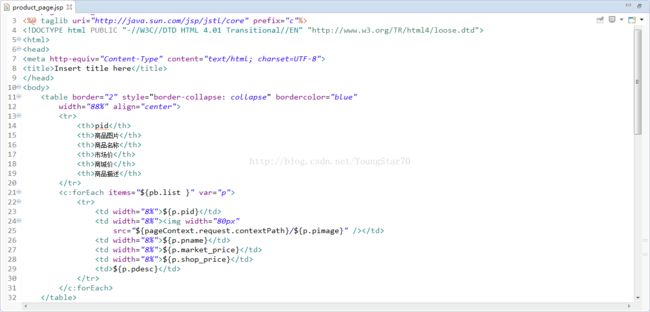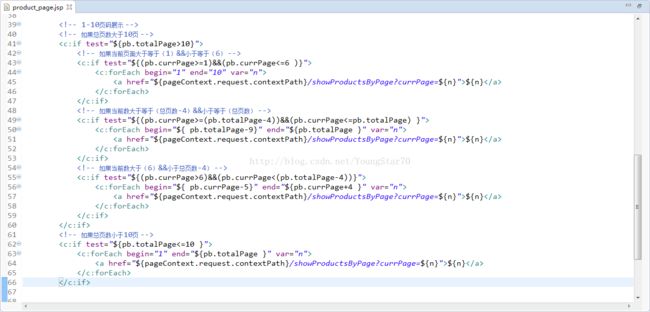JSP+Servlet技术实现分页 首页 下一页 每一页显示10条页码 下一页 尾页 第页/共页 (利用PageBean实现)
前端JSP页面的代码:
<%@ page language="java" contentType="text/html; charset=UTF-8"
pageEncoding="UTF-8"%>
<%@ taglib uri="http://java.sun.com/jsp/jstl/core" prefix="c"%>
Insert title here
pid
商品图片
商品名称
市场价
商城价
商品描述
${p.pid}

${p.pname}
${p.market_price}
${p.shop_price}
${p.pdesc}
[首页]
[上一页]
${n}
${n}
${n}
${n}
[下一页]
[尾页]
第${pb.currPage }页/共${pb.totalPage }页
商品详情显示的代码:
首页 上一页的代码
每一页显示10条页码的代码:
下一页 尾页 第页/共页的代码:
分页效果显示:
后端的代码:
PageBean的代码:
package com.itheima.domain;
import java.util.List;
public class PageBean {
private List list; // 当前页内容 查询
private int currPage; // 当前页码 传递
private int pageSize; // 每页显示的条数 固定
private int totalCount; // 总条数 查询
private int totalPage; // 总页数 计算
public List getList() {
return list;
}
public void setList(List list) {
this.list = list;
}
public int getCurrPage() {
return currPage;
}
public void setCurrPage(int currPage) {
this.currPage = currPage;
}
public int getPageSize() {
return pageSize;
}
public void setPageSize(int pageSize) {
this.pageSize = pageSize;
}
public int getTotalCount() {
return totalCount;
}
public void setTotalCount(int totalCount) {
this.totalCount = totalCount;
}
public int getTotalPage() {
return (int) Math.ceil(totalCount * 1.0 / pageSize);
}
public PageBean() {
}
public PageBean(List list, int currPage, int pageSize, int totalCount) {
super();
this.list = list;
this.currPage = currPage;
this.pageSize = pageSize;
this.totalCount = totalCount;
}
}
ShowProductsByPageServlet的代码:
package com.itheima.web.servlet;
import java.io.IOException;
import java.sql.SQLException;
import javax.servlet.ServletException;
import javax.servlet.http.HttpServlet;
import javax.servlet.http.HttpServletRequest;
import javax.servlet.http.HttpServletResponse;
import com.itheima.domain.PageBean;
import com.itheima.domain.Product;
import com.itheima.service.ProductService;
/**
* 分页展示数据
*/
public class ShowProductsByPageServlet extends HttpServlet {
private static final long serialVersionUID = 1L;
protected void doGet(HttpServletRequest request, HttpServletResponse response)
throws ServletException, IOException {
int currPage = Integer.parseInt(request.getParameter("currPage"));
int pageSize = 3;
PageBean bean = null;
try {
bean = new ProductService().showProductsByPage(currPage, pageSize);
} catch (SQLException e) {
e.printStackTrace();
}
request.setAttribute("pb", bean);
request.getRequestDispatcher("/product_page.jsp").forward(request, response);
}
protected void doPost(HttpServletRequest request, HttpServletResponse response)
throws ServletException, IOException {
doGet(request, response);
}
}
ProductService的代码:
/**
* 分页查询商品
* @param currPage 第几页
* @param pageSize 每页显示的条数
* @return
* @throws SQLException
*/
public PageBean showProductsByPage(int currPage, int pageSize) throws SQLException {
ProductDao dao=new ProductDao();
List list=dao.findProductByPage(currPage,pageSize);
int totalCount=dao.getCount();
return new PageBean<>(list, currPage, pageSize, totalCount);
} ProductDao的代码:
public List findProductByPage(int currPage, int pageSize) throws SQLException {
QueryRunner qr=new QueryRunner(DataSourceUtils.getDataSource());
String sql="select * from product limit ?,?";
return qr.query(sql, new BeanListHandler<>(Product.class),(currPage-1)*pageSize,pageSize);
}
public int getCount() throws SQLException {
QueryRunner qr=new QueryRunner(DataSourceUtils.getDataSource());
String sql="select count(*) from product";
return ((Long)qr.query(sql, new ScalarHandler<>())).intValue();
} 



